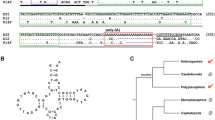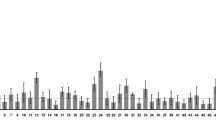Abstract
Our group demonstrated recently that the 3 ′ ends of several families of tRNA-derived SINEs (short interspersed repetitive elements) originated from the 3′ ends of LINEs (long interspersed repetitive elements) [Ohshima et al. (1996) Mol. Cell. Biol. 16:3756-3764]. Two fully characterized examples of such organization were provided by the tortoise Pol III/SINE and the salmonid Hpal family of SINEs, and two probable examples were provided by the tobacco TS family of SINEs and the salmon Smal family of SINEs. This organization of SINEs can explain their potential to retropose in the genome since it appears reasonable that the sites for recognition of LINEs by reverse transcriptase should be located within the 3′-end sequences of LINEs. We now add another example to this category of SINEs. In the bovine genome, there are Bov-tA SINEs, which belong to the superfamily of tRNA-derived families of SINEs, and Bov-B LINEs, which were recently demonstrated to belong to a LINE family. Moreover, Bov-tA and Bov-B share the same 3′-end tail. We propose a possible scenario whereby the composite structure of the bovine Bov-tA family of SINEs might have been generated from the Bov-B family of LINEs during evolution.
Similar content being viewed by others
References
Burch JBE, Davis DL, Haas NB (1993) Chicken repeat 1 elements contain a pol-like open reading frame and belong to the non-long terminal repeat class of retrotransposons. Proc Natl Acad Sci USA 90:8199–8203
Daniels GR, Deininger PL (1983) A second major class of Alu family repeated DNA sequences in a primate genome. Nucleic Acids Res 11:7595–7610
Doolittle RF, Feng D-F, Johnson MS, McClure MA (1989) Origins and evolutionary relationships of retroviruses. Q Rev Biol 64:1–30
Duncan CH (1987) Novel Alu-type repeat in artiodactyls. Nucleic Acids Res 15:1340
Eickbush TH (1992) Transposing without ends: the non-LTR retrotransposable elements. New Biol 4:430–440
Eickbush TH (1994) Origin and evolutionary relationships of retroelements. In: Morse SS (ed) The evolutionary biology of viruses. Raven Press, New York, pp 121–157
Endoh H, Okada N (1986) Total DNA transcription in vitro: a procedure to detect highly repetitive and transcribable sequences with tRNA-like structures. Proc Natl Acad Sci USA 83:251–255
Endoh H, Nagahashi S, Okada N (1990) A highly repetitive and transcribable sequence in the tortoise genome is probably a retroposon. Eur J Biochem 189:25–31
Fanning TG, Singer MF (1987) LINE-1: a mammalian transposable element. Biochem Biophys Acta 910:203–212
Groenen MAM, Dijkhof RJM, Verstege AJM, Van der Poel JJ (1993) The complete sequence of the gene encoding bovine as 2-casein. Gene 123:187–193
Kido Y, Aono M, Yamaki T, Matsumoto K, Murata S, Saneyoshi M, Okada N (1991) Shaping and reshaping of salmonid genomes by amplification of tRNA-derived retroposons during evolution. Proc Natl Acad Sci USA 88:2326–2330
Kido Y, Himberg M, Takasaki N, Okada N (1994) Amplification of distinct subfamilies of short interspersed elements during evolution of the salmonidae. J Mol Biol 241:633–644
Kido Y, Saitoh M, Murata S, Okada N (1995) Evolution of the active sequences of the Hpal short interspersed elements. J Mol Evol 41:986–995
Lenstra JA, Boxtel JAF, Zwaagstra KA, Schwerin M (1993) Short interspersed nuclear element (SINE) sequences of the Bovidae. Anim Genet 24:33–39
Luan DD, Eickbush TH (1995) RNA template requirements for target DNA-primed reverse transcription by the R2 retrotransposable element. Mol Cell Biol 15:3882–3891
Luan DD, Korman MH, Jakubczak JL, Eickbush TH (1993) Reverse transcription of R2Bm RNA is primed by a nick at the chromosomal target site: a mechanism for non-LTR retrotransposition. Cell 72:595–605
Okada N (1991a) SINEs. Curr Opin Genet Dev 1:498–504
Okada N (1991b) SINEs: short interspersed repeated elements of the eukaryotic genome. Trends Ecol Evol 6:358–361
Okada N, Ohshima K (1995) Evolution of tRNA-derived SINEs. In: Maraia RJ (ed) The impact of short interspersed elements (SINEs) on the Host genome. R G Landes, Austin, TX pp 61–79
Ohshima K, Koishi R, Matsuo M, Okada N (1993) Several short interspersed repetitive elements (SINEs) in distant species may have originated from a common ancestral retrovirus: characterization of a squid SINE and a possible mechanism for generation of tRNA-derived retroposons. Proc Natl Acad Sci USA 90:6260–6264
Ohshima K, Hamada M, Terai Y, Okada N (1996) The 3′ ends of tRNA-derived short interspersed repetitive elements are derived from the 3′ ends of long interspersed repetitive elements. Mol Cell Biol 16:3756–3764
Rogers JH (1985) The structure and evolution of retroposons. Int Rev Cytol 93:231–279
Sakamoto K, Okada N (1985) Rodent type 2 Alu family, rat identifier sequence, rabbit C family, and bovine or goat 73-bp repeat may have evolved from tRNA genes. J Mol Evol 22:134–140
Spence SE, Young RM, Garner KJ, Lingrel JB (1985) Localization and characterization of members of a family of repetitive sequences in the goat β globin locus. Nucleic Acids Res 13:2171–2186
Szemraj J, Plucienniczak G, Jaworski J, Plucienniczak A (1995) Bovine Alu-Iike sequences mediate transposition of a new site-specific retroelement. Gene 152:261–264
Ullu E, Tschudi C (1984) Alu sequences are processed 7SL RNA genes. Nature 312:171–172
Weiner AM (1980) An abundant cytoplasmic 7S RNA is complementary to the dominant interspersed middle repetitive DNA sequence family in the human genome. Cell 22:209–218
Weiner AM, Deininger PL, Efstratiadis A (1986) Nonviral retroposons: genes, pseudogenes, and transposable elements generated by the reverse flow of genetic information. Annu Rev Biochem 55:631–661
Xiong Y, Eickbush TH (1990) Origin and evolution of retroelements based upon their reverse transcriptase sequences. EMBO J 9:3353–3362
Yoshioka Y, Matsumoto S, Kojima S, Ohshima K, Okada N, Machida Y (1993) Molecular characterization of a short interspersed repetitive element from tobacco that exhibits sequence homology to specific tRNAs. Proc Natl Acad Sci USA 90:6562–6566
Zelnick CR, Burks DJ, Duncan CH (1987) A composite transposon 3′ to the cow fetal globin gene binds a sequence specific factor. Nucleic Acids Res 15:10437–10453
Author information
Authors and Affiliations
Rights and permissions
About this article
Cite this article
Okada, N., Hamada, M. The 3′ ends of tRNA-derived SINEs originated from the 3’ ends of LINEs: A new example from the bovine genome. J Mol Evol 44 (Suppl 1), S52–S56 (1997). https://doi.org/10.1007/PL00000058
Received:
Accepted:
Issue Date:
DOI: https://doi.org/10.1007/PL00000058




